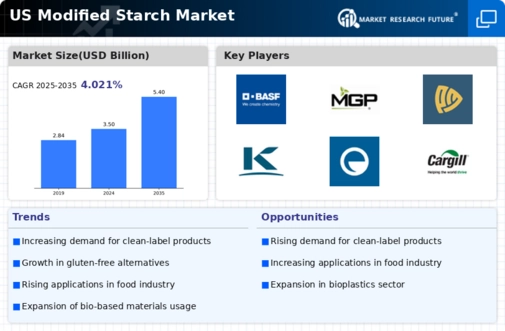Growth in Beverage Sector
The modified starch market is significantly influenced by the growth in the beverage sector, where these starches are utilized for their thickening and stabilizing properties. In 2025, the beverage industry represents a substantial portion of modified starch usage, particularly in non-alcoholic drinks, where they enhance mouthfeel and texture. The increasing consumer inclination towards innovative beverage formulations, including smoothies and functional drinks, is likely to drive demand for modified starches. Furthermore, the trend towards healthier beverage options may lead manufacturers to incorporate modified starches as natural thickeners, thereby supporting the modified starch market. This growth trajectory in the beverage sector suggests a promising outlook for modified starch applications, as companies strive to meet evolving consumer preferences.
Expansion of the Pharmaceutical Sector
The modified starch market is also experiencing growth due to the expansion of the pharmaceutical sector, where these starches are utilized as excipients in drug formulations. Modified starches serve as binders, disintegrants, and fillers, playing a crucial role in the production of tablets and capsules. In 2025, the pharmaceutical industry is expected to account for a growing share of modified starch consumption, driven by the increasing demand for generic drugs and over-the-counter medications. As pharmaceutical companies continue to innovate and develop new formulations, the reliance on modified starches is likely to increase, thereby enhancing the modified starch market. This trend indicates a diversification of applications for modified starches, further solidifying their importance across various industries.
Rising Demand for Gluten-Free Products
The modified starch market is benefiting from the rising demand for gluten-free products, which has become a significant trend in the US food landscape. As consumers increasingly seek gluten-free alternatives due to health concerns or dietary preferences, modified starches are often employed as binding agents and texturizers in gluten-free formulations. In 2025, the gluten-free food segment is projected to grow at a CAGR of around 10%, further propelling the modified starch market. This shift not only caters to a niche market but also encourages innovation in product development, as manufacturers explore new ways to enhance the quality and appeal of gluten-free offerings. Consequently, the modified starch market is likely to see sustained growth as it aligns with this evolving consumer demand.
Increasing Application in Food Industry
The modified starch market is experiencing a notable surge in demand due to its increasing application in the food industry. Modified starches serve as thickeners, stabilizers, and emulsifiers, enhancing the texture and shelf life of various food products. In 2025, the food sector accounts for approximately 60% of the total modified starch consumption in the US. This trend is driven by the growing consumer preference for convenience foods, which often require modified starches to maintain quality during processing and storage. Additionally, the rise in ready-to-eat meals and processed snacks further propels the modified starch market, as manufacturers seek to improve product consistency and performance. As a result, the food industry's expansion is likely to continue fueling growth in the modified starch market, indicating a robust future for this segment.
Technological Innovations in Processing
Technological innovations in processing are significantly impacting the modified starch market, as advancements in production techniques enhance the quality and functionality of modified starches. Innovations such as enzymatic modification and high-temperature processing allow for the development of starches with tailored properties, meeting specific industry requirements. In 2025, the adoption of these technologies is expected to increase, driven by the need for improved efficiency and product performance. As manufacturers seek to optimize their production processes, the modified starch market is likely to benefit from these advancements, leading to a broader range of applications across food, beverage, and pharmaceutical sectors. This ongoing evolution in processing technology suggests a dynamic future for the modified starch market, as it adapts to meet the demands of various industries.






















Leave a Comment